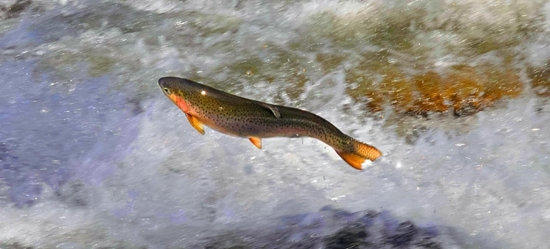Production of Caspian trout (Salmo trutta caspius) gametes in salmon, using stem cell technology
For the first time in the country, using stem cell technology and forming chimeric fish (chimera), the possibility of producing Caspian salmon gametes in rainbow trout was realized by researchers at TMU and Royan Research Institute.

Sprmatogonial stem cells (SSCs) are valuable for preservation of endangered fish species, biological experimentation, as well as biotechnological applications. However, the rarity of SSCs in the testes has been a great obstacle in their application. Thus, establishment of an efficient in-vitro culture system to support continuous proliferation of SSCs is essential. This project has been completed in the form of a research dissertation by Ms. Samaneh PourSaeed. Pointing to teamwork in the scientific project, Pour Saeed said: "In order to protect the Caspian trout species (economically valuable and on the verge of extinction), researchers at TMU's Marine Sciences faculty in collaboration with researchers at the Royan Research Institute and Tokyo Marine Technology and Science University succeeded (for the first time in the country) in producing chimeric fish by culturing the spermatogonial stem cells of the Caspian Sea salmon and transplanting these cells into the rainbow trout larvae. The study aimed to establish an efficient and simple method for in vitro culture of Caspian trout undifferentiated spermatogonial cells. Using a two-step enzymatic digestion, testicular cells were isolated from immature testes composed of mainly undifferentiated spermatogonial cells with gonadosomatic indices of < ۰.۰۵٪. The spermatogonial cells were purified by differential plating through serial passaging. The purified cells indicated high expression of type A spermatogonia-related genes (ly75, gfr?1, nanos2, plzf and vasa). Proliferation of purified cells was confirmed by BrdU incorporation. Co-culture of purified cells with testicular somatic cells as a feeder layer, resulted in continuous proliferation of type A spermatogonia. The cultured cells continued to express type A spermatogonia-specific markers after one month culture. The cultured spermatogonia were successfully incorporated into the germline after being intraperitoneally transplanted into sterile triploid rainbow trout hatchlings. These results, for the first time, demonstrated that the somatic microenvironment of the rainbow trout gonad can support the colonization and survival of intraperitoneally transplanted cells derived from a fish species belonging to a different genus. Therefore, the combination of in vitro culture system and xenotransplantation can be considered as a promising strategy for conservation of Caspian trout genetic resources. Part of the results are published in the International Journal of General and Comparative Endocrinology. The project has been completed in the form of a dissertation by Dr. Samaneh Porsaid, a TMU graduate, with the guidance of Dr. Mohammad Reza Kalbasi, Dr. Hossein Baharvand, Dr. Seyedeh Nafiseh Hassani, and Dr. Garou Yoshizaki. Caspian trout (Salmo trutta caspius) is one of the migratory fish species which lives and feeds in the Caspian Sea. This species distributed in south and western of the Caspian Sea.
